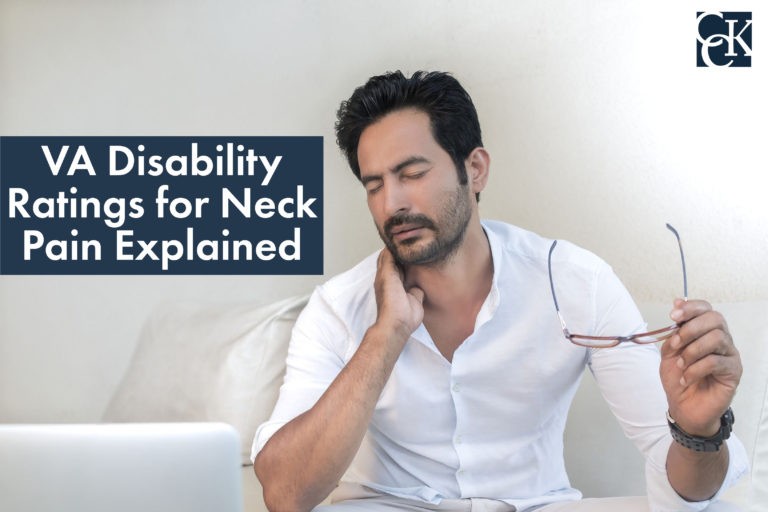VA Disability Ratings for Neck Pain Explained

CCK Law: Our Vital Role in Veterans Law
Orthopedic conditions are typically categorized as those that impact the musculoskeletal system. Common orthopedic conditions impacting veterans include neck pain and low back pain.
In the VA rating system, orthopedic conditions affecting the spine are separated into neck conditions and back conditions. Neck conditions typically affect the cervical spine, which consists of seven bones (vertebrae) that are separated by intervertebral discs. Back conditions typically correspond to the thoracolumbar spine, which is composed of several different types of vertebrae. Though back and neck conditions both stem from the spine in most instances, VA rates them as separate disabilities.
How to Establish VA Service Connection for Neck Pain
Veterans may be eligible to receive service-connected compensation for neck pain if they are able to prove that their neck pain is a result of their time in service. Importantly, VA reserves disability benefits for those veterans with chronic neck pain. In other words, VA will not award a compensable rating for a neck condition that was present at one time or another but has since resolved. However, veterans can get service-connected for neck pain or a neck condition that existed prior to service and was aggravated by service.
Generally speaking, establishing service connection for a medical condition requires a diagnosis from a doctor, evidence of an in-service event or cause of the condition, and a nexus (e.g., medical opinion) that links the condition to time in service. However, conditions like neck pain often do not have a definitive cause, which can make it impossible to get a clear medical diagnosis. Fortunately, in an April 2018 case called Saunders v. Wilkie, the Federal Circuit held that VA can award disability compensation for a veteran’s undiagnosed pain if it is linked to an in-service event, injury, or symptom. The Federal Circuit’s ruling means that the first element of direct service connection, the current medical diagnosis, does not require the veteran to identify a specific underlying condition. Veterans will still need to show VA that there was an in-service event, injury, or symptom that caused their pain, and they will need to provide a medical nexus linking their pain to that in-service incident or symptom.
Types of Evidence That Can Support a Neck Pain VA Claim
Veterans should submit evidence that their neck pain is recurring or long-lasting and interferes with daily life. For example:
- A lay statement from the veteran or a family member who has witnessed the way the veteran’s neck pain interferes with daily life.
- Military records, such as medical records or personnel files, which display an incident or activity that could have led to the neck condition.
In all events, the veteran’s pain must cause functional impairment or loss, defined as the inability to perform the working movements of the body with normal strength, speed, coordination, and endurance. Importantly, subjective complaints of pain are not enough to be awarded disability compensation.
Common Types of Neck Injuries
- Whiplash – Whiplash is a neck injury that occurs when the neck sustains a forceful motion back and forth. This motion is often compared to the cracking of a whip, which is where the name comes from.
- Spinal Cord Injury – Injuries to the spinal cord are often very serious and can result in loss of feeling or motion. Car accidents, gun shot wounds, and serious falls can cause trauma to the spine and injure it. Spinal cord injuries can even sever the spinal cord. However, in most cases the spinal cord is intact but damaged to the point of loss of function.
- Disc Injury – Disc injuries, such as a herniated disc, affect the discs that rest between the vertebrae of the spine. Symptoms of disc injuries include numbness, weakness, and pain.
- Nerve Pinch – Pinched nerves can arise when too much pressure is placed on a nerve by the surrounding bones, cartilage, muscles, or tendons. Numbness, sharp pain, the sensation of pins and needles, or muscle weakness can occur when a nerve has been pinched. In some cases, surgery is needed to relieve the pain.
- Repetitive Strain – Repetitive strain injuries can cause pain, aching, cramping, throbbing, tingling, or stiffness. Symptoms can worsen over time and may only occur when performing a repetitive action.
- Degenerative Disc Disease – Degenerative Disc Disease occurs when the discs that rest between the vertebrae of the spine begin to deteriorate and break down after time. This condition can be diagnosed by a doctor. Symptoms often include radiating pain down the leg, numbness, and weakness.
- Foraminal Stenosis – Foraminal stenosis refers to the tightening of the openings, or foramen, between the bones in the spine. Foraminal stenosis is a specific form of spinal stenosis, another condition relating to the narrowing of the spine.
- Intervertebral Disc Disease – Similar to Degenerative Disc Disease, intervertebral disc disease affects the discs that sit between the vertebrae. Intervertebral disc disease cause pain in the neck, back, legs, and arms.
How Does VA Rate Neck Pain?
Similar to VA disability ratings for back pain, VA uses the General Rating Formula for Diseases and Injuries of the Spine under 38 CFR § 4.71a to evaluate the majority of neck pain conditions. This rating formula is based mainly on range of motion measurements according to the following criteria:
- “100% – unfavorable ankylosis of the entire spine
- 50% – unfavorable ankylosis of the entire thoracolumbar spine
- 40% – unfavorable ankylosis of the entire cervical spine; or forward flexion of the thoracolumbar spine 30 degrees or less; or favorable ankylosis of the entire thoracolumbar spine
- 30% – forward flexion of the cervical spine 15 degrees or less; or, favorable ankylosis of the entire cervical spine
- 20% – forward flexion of the thoracolumbar spine greater than 30 degrees but not greater than 60 degrees; or, forward flexion of the cervical spine greater than 15 degrees but not greater than 30 degrees; or, the combined range of motion of the thoracolumbar spine not greater than 120 degrees; or, the combined range of motion of the cervical spine not greater than 170 degrees; or, muscle spasm or guarding severe enough to result in an abnormal spine contour such as scoliosis, reversed lordosis, or abnormal kyphosis
- 10% – forward flexion of the thoracolumbar spine greater than 60 degrees but not greater than 85 degrees; or, forward flexion of the cervical spine greater than 30 degrees but not greater than 40 degrees; or, combined range of motion of the thoracolumbar spine greater than 120 degrees but not greater than 235 degrees; or, combined range of motion of the cervical spine greater than 170 degrees but not resulting in abnormal gait or abnormal spine contour; or, vertebral body fracture with loss of 50 percent or more of the height”
Examples of conditions that often cause neck pain are rated using the above formula include the following:
- Cervical strain (Diagnostic Code 5237) – stretched or torn muscle or tendon in the neck
- Degenerative arthritis of the spine (Diagnostic Code 5242) – degeneration of the cervical vertebrae resulting in pain
- Cervical spine stenosis (Diagnostic Code 5238) – narrowing of the spinal canal in the neck

Secondary Service Connection for Conditions Associated with Neck Pain
Secondary service connection is when a veteran’s already service-connected condition causes a new, separate disability, or aggravates a preexisting disability, that is not service-connected. Veterans can receive disability compensation for that new or aggravated condition as a result of their already service-connected disability.
Secondary conditions commonly occur as the result of service-connected orthopedic conditions. Examples of secondary conditions associated with neck pain include radiculopathy, due to a compressed nerve in the cervical spine, and migraine headaches. To establish secondary service connection for these conditions, veterans must show that the onset and/or progression of each condition is the result of their neck pain.
Compensation and Pension (C&P) Exams for Neck Conditions
VA may request a compensation and pension examination to assess the veteran’s neck and the connection the condition may have to service. The examiner will usually either be a VA physician or a VA contracted physician. The examiner may ask questions about the condition or time in service, as well as physically examine the veteran.
In instances where range of motion of the neck needs to be measured, the examiner will typically use a goniometer to obtain a precise measurement.
After the exam, the VA examiner will issue an opinion stating whether they believe your condition is related to service or not. An unfavorable opinion will not support service connection, while a favorable opinion will.
Obtaining TDIU for Neck Pain
While the highest rating for neck pain will typically be forty percent, unless there are secondary conditions linked to the neck condition, veterans can obtain a one hundred percent rating through TDIU, or total disability based on individual unemployability. To be awarded the one hundred percent rating, veterans wi.ll have to show that the functional limitations of the neck condition inhibit the veteran from holding substantially gainful employment.
In other words, if a veteran’s neck pain and any other conditions they may have prevent them from making enough income to support themselves, they may be awarded TDIU. There are two ways to be awarded TDIU, often referred to as schedular and extraschedular.
- 38 CFR § 4.16a (“Schedular”) – To be eligible for this form of TDIU, the veteran will need to have one condition rated at minimum 60 percent or two conditions that can be combined to reach at least 70 percent, with one condition being a minimum of 40 percent
- 38 CFR § 4.16b (“Extraschedular”) – This form of TDIU is for veterans who, despite their ratings, are still unable to obtain substantially gainful employment. To be eligible, veterans must indicate that their condition is unique and should not be rated on the standard disability rating schedule, as it would not adequately reflect the way their condition limits their functional capacity.
Was Your VA Disability Claim for Neck Pain Denied?
The experienced and VA-accredited attorneys and advocates have decades of experience successfully representing veterans and their dependents before the Department of Veterans Affairs, the Court of Appeals for Veterans Claims, and the Federal Circuit. For a free case evaluation, please contact us at 800-544-9144
About the Author
Share this Post
